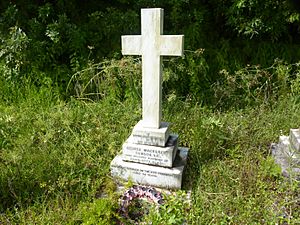George Samson facts for kids
Quick facts for kids
George Samson
|
|
|---|---|
 |
|
| Born | 7 January 1889 Carnoustie, Forfarshire, Scotland |
| Died | 28 February 1923 (aged 34) Aboard the SS Strombus |
| Buried |
Methodist Cemetery, St. George's, Bermuda
|
| Allegiance | |
| Service/ |
|
| Rank | Petty officer |
| Unit | HMS Hussar SS River Clyde |
| Battles/wars | World War I |
| Awards | Victoria Cross Médaille militaire (France) |
| Other work | Merchant seaman |
George McKenzie Samson was a brave Scottish sailor. He was given the Victoria Cross (VC), which is the highest award for bravery in the face of the enemy for British and Commonwealth soldiers. He earned this special medal during the First World War for his actions in the Gallipoli Campaign. George Samson was born on January 7, 1889, in Carnoustie, Scotland. He was 26 years old and a seaman in the Royal Naval Reserve when he received the VC. He passed away on February 28, 1923.
Contents
Who Was George Samson?
George McKenzie Samson was a Scottish hero. He served in the Royal Naval Reserve, which is part of the Royal Navy. This group helps protect the seas for the United Kingdom. He was a seaman, which is a rank for a sailor.
The Victoria Cross
The Victoria Cross is the most important award for bravery in the British military. It is given to soldiers, sailors, and airmen who show amazing courage. They must face the enemy with great bravery. George Samson earned this medal because of his incredible actions during a big battle.
The First World War
The First World War was a huge global conflict. It lasted from 1914 to 1918. Many countries around the world were involved. George Samson fought in this war. He was part of a major battle called the Gallipoli Campaign.
Bravery at Gallipoli
On April 25, 1915, a big landing took place at a place called V Beach. This was part of the Gallipoli Campaign. George Samson was there with his ship, the HMS River Clyde. He and three other men helped their commander, Edward Unwin. Their job was to secure the "lighters." Lighters are like small barges. They are used to carry soldiers and supplies from big ships to the shore.
Under Heavy Fire
George Samson worked all day long. He was under very heavy enemy fire. This means that bullets and shells were flying all around him. Even with this danger, he kept working. He helped to secure the lighters. He also helped many wounded soldiers. He made sure they were safe and cared for.
A Serious Injury
During this brave work, George Samson was seriously hurt. He was hit by fire from a Maxim machine gun. These guns could fire many bullets very quickly. Despite his injury, his actions helped many people. They also helped the landing operation.
Life After the War
After the war, George Samson continued his life as a sailor. He became a petty officer, which is a higher rank in the navy. He joined the Merchant Navy. This group of ships carries goods and people around the world.
A Difficult Moment
One time, after the war, George Samson was going to a special event. It was a public reception to honor him. Someone gave him a "white feather." In those days, a white feather was sometimes given to men. It was a way to suggest they were not brave enough to fight. This was a very unfair thing to do. George Samson had already shown incredible bravery. He had earned the highest award for courage.
His Final Resting Place
Sadly, George Samson passed away on February 28, 1923. He died from pneumonia. He was aboard a ship called the SS Strombus at the time. He is buried in the Methodist Cemetery in St. George's, Bermuda. His Victoria Cross medal is now on display. You can see it in the Lord Ashcroft Gallery. This gallery is inside the Imperial War Museum in London.
Images for kids



